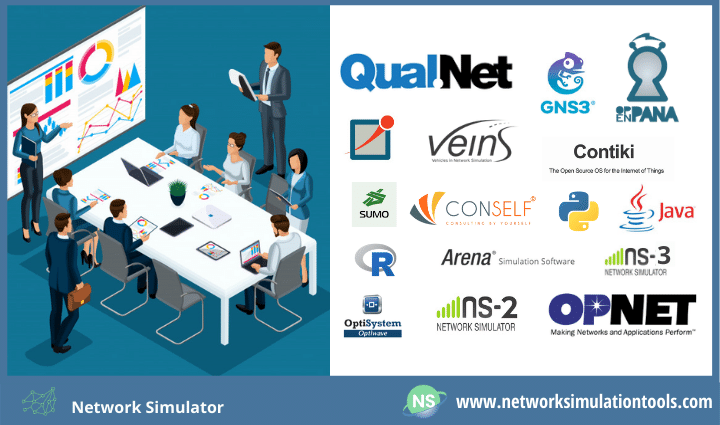We have listed below important network simulator parameters metric to be noted during implementation of network simulation projects.
Reach Networksimulationtools.com to get a customized Network simulator project with source code using various network simulation tools.
Important Network Simulator Parameters
Quality of Service
- It defines the quality in which the data is transmitted from the sender to the receiver. It also includes the success in packet delivery and the quality of the packets.
Packet Delivery Ratio
- It is in short as PDR that defines the total number of packets that are successfully transmitted from a node.
End-to-End Delay
- This metric denotes the time delay that occurs in the path while the data is transmitted between source to destination.
Throughput
- This parameter defines successful packet transmission in accordance with the time.
Latency
- It is the measure of time that is taken by a bit of packet to travel towards its next-hop neighbor node.
The velocity of the node
- This metric is defined only for a dynamic network in which the nodes move at different speeds in the network.
Jitter
- This parameter is the measure of the existence of latency in the transmission of the packet.
Energy Utilization
- The amount of energy that is utilized by the nodes in the networks is measured with respect to the initial energy.
Overhead in routing
- This parameter is estimated while the routing protocol is used. This defines the enormous flow of packets at limited bandwidth is called routing overhead.
Percentage of packet loss
- This metric determines the number of packets that are lost on each transmission of the pairs of source and destination.
Routing hop count
- This parameter defines the number of hops that are present in the selected routing path. The lesser the hop counts give the shortest route.
Received signal strength
- This metric enables to compute the amount of power that is present in the signals during transmission.
Network Congestion
- The parameter congestion denotes the clashing of signals between two or more devices in the network.
Network Efficiency
- The efficiency deals with the correctness in the exchange of the data in the whole network. As a total measure, this network efficiency is evaluated.
Lifetime of Network
- The network lifetime depends on the amount of energy consumed by all the nodes in the network.
Number of alive nodes
- This metric is computed in number as per the active nodes at the end of simulation after a particular time period.
Network Resiliency
- This metric determines the network’s ability that depends on the capability of the scalable and reliable aspects of the network.
Time for encryption and decryption
- It defines the cryptography algorithm’s time to convert the plain text into ciphertext and vice versa.
Detection accuracy
- This parameter gives the exactness in the identification of the attackers participating in the network.
Traveling path length
- The path of moving network nodes is measure in meters or kilometers to identify their ability in traveling.
Load balance factor
- This is a factor that defines the number of packets that are buffered in a particular network device that may overflow.
Security level
- The level of security is measured in terms of bits where the strongest ciphertext is determined.
Number of Handovers
- The handover metric defines the number of times a particular device moves from one connectivity to another.
Signal to Noise ratio
- The SNR gives the amount of noise and signals that exist in a particular channel between two nodes.
Migration time
- This determines the time taken for the migration of packets from one network entity to another.
Cluster head lifetime
- This metric denotes the amount of time the selected cluster head sustains as ahead for that cluster.
Redundancy Check
- This parameter gives the amount of redundant data packet that is present in the collected packets.
Percentage of Packet drop
- This metric defines the number of packets that are dropped in the link during data transmission.
Response time
- The time taken for the node to receive a response for the given request defines the response time.
Satisfaction rate
- This metric defines the satisfaction of the given request by the node for particular content.
Resource utilization
- This parameter defines the number of resources used in the network by the nodes for their transmission.
Scalability
- The scalability measures the ability of the network at an increasing number of nodes in the network.
Bandwidth consumption
- This metric defines the amount of bandwidth that is consumed by the nodes to perform their transmission.
Data rate
- Data rate denotes the use of communication technology that gives faster speed in data transmission.
Node degree
- The node degree defines the number of nodes that are connected to a particular node. In simple, this means connectivity.
Number of clusters
- This parameter defines the number of clusters that are created in the network. The performance at a larger and smaller number of clusters is analyzed.
Queue time
- This metric is a measure of time that is determined from the time at which the packets stay in a buffer of the node.
